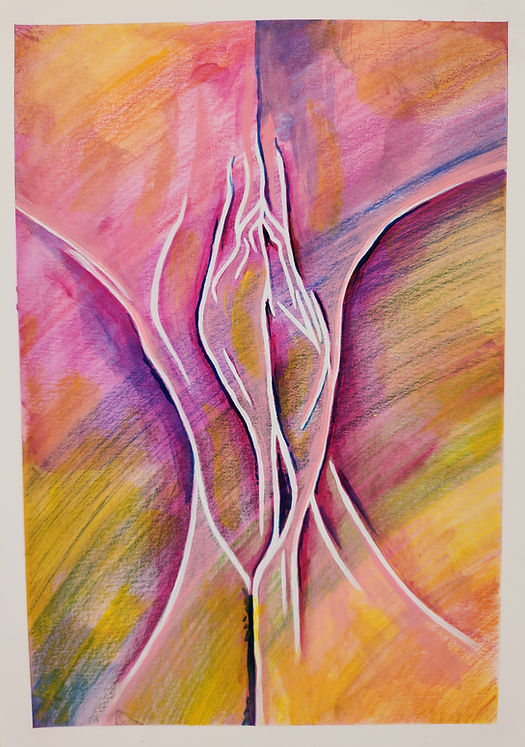I have been friends with Gwendolyn for many years, and earlier this year, she underwent gender-affirming surgery. At a recent party, she excitedly shared a picture of her new vulva, and I was in awe of her beauty and the incredible journey she has taken. I felt compelled to celebrate her transformation through art, so I asked for her permission to create paintings of her vulva. We arranged to meet for a deeper conversation about her story.
Gwendolyn was born with male genitalia and assigned male at birth. For much of her life, she felt a disconnect between her identity and her body. Before her transition, she presented as Greg, navigating a world that often failed to understand her true self. It wasn't until two and a half years ago that a pivotal MRI revealed her intersex identity. What had been misdiagnosed as irritable bowel syndrome (IBS) was, in fact, the result of internal menstruation due to her unique anatomy, which included internal ovaries, a womb, and a uterus alongside male genitalia. This discovery was a transformative moment for her—what she describes as a "penny drop moment"—that brought a profound sense of understanding to her life.
Gwendolyn expresses discomfort with the term "dead name," which is often used in the trans community to refer to a person's former name. She emphasises the importance of recognising and integrating one's past as part of the journey. As a mentor to younger individuals in the trans community, she encourages them to embrace their past selves while celebrating their current identities. As she puts it, "Words are spells," highlighting the power of language in shaping self-perception.
Gwendolyn has faced challenges in accessing informed healthcare in New Zealand, particularly concerning hormone levels. In contrast, her experience in Thailand during her surgeries included regular hormone level testing, which is crucial for effective transitioning. She notes that estrogen patches often become less effective over time, necessitating estrogen shots and specialist care.
Gwendolyn advocates for the normalisation of discussions surrounding sex, gender, and reproductive health, especially for children. She believes that fostering a sense of belonging is vital, as children are particularly vulnerable to manipulation. Tragically, the trans community experiences a high prevalence of sexual assault, underscoring the need for education and awareness.
Looking ahead, Gwendolyn is excited to pursue a degree in psychotherapy to further support the trans community. Her journey is a powerful testament to resilience, acceptance, and the importance of compassionate dialogue.
Gwendolyn was born with male genitalia and assigned male at birth. For much of her life, she felt a disconnect between her identity and her body. Before her transition, she presented as Greg, navigating a world that often failed to understand her true self. It wasn't until two and a half years ago that a pivotal MRI revealed her intersex identity. What had been misdiagnosed as irritable bowel syndrome (IBS) was, in fact, the result of internal menstruation due to her unique anatomy, which included internal ovaries, a womb, and a uterus alongside male genitalia. This discovery was a transformative moment for her—what she describes as a "penny drop moment"—that brought a profound sense of understanding to her life.
Gwendolyn expresses discomfort with the term "dead name," which is often used in the trans community to refer to a person's former name. She emphasises the importance of recognising and integrating one's past as part of the journey. As a mentor to younger individuals in the trans community, she encourages them to embrace their past selves while celebrating their current identities. As she puts it, "Words are spells," highlighting the power of language in shaping self-perception.
Gwendolyn has faced challenges in accessing informed healthcare in New Zealand, particularly concerning hormone levels. In contrast, her experience in Thailand during her surgeries included regular hormone level testing, which is crucial for effective transitioning. She notes that estrogen patches often become less effective over time, necessitating estrogen shots and specialist care.
Gwendolyn advocates for the normalisation of discussions surrounding sex, gender, and reproductive health, especially for children. She believes that fostering a sense of belonging is vital, as children are particularly vulnerable to manipulation. Tragically, the trans community experiences a high prevalence of sexual assault, underscoring the need for education and awareness.
Looking ahead, Gwendolyn is excited to pursue a degree in psychotherapy to further support the trans community. Her journey is a powerful testament to resilience, acceptance, and the importance of compassionate dialogue.


